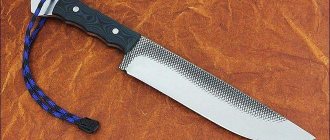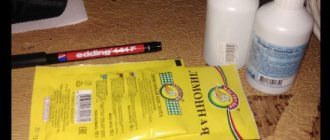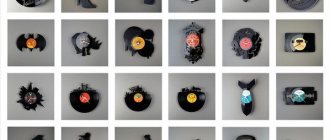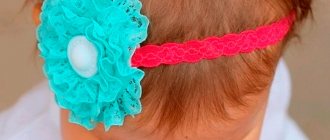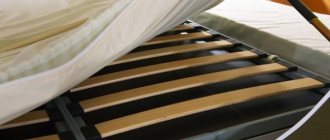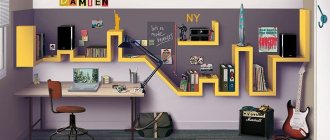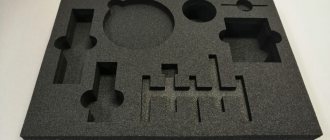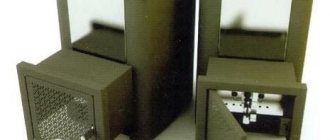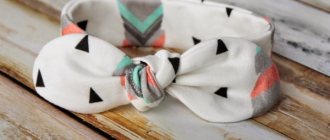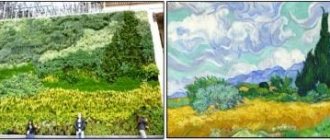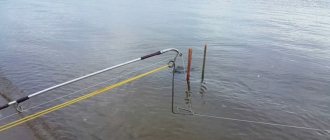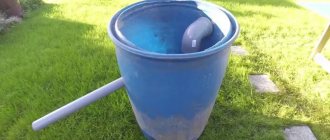The process of metal etching has been known to people since the 16th century. The most famous masters lived in Italy and Germany. Today, anyone in the world can do knife etching at home. The availability of reagents and many methods allows you to do this without special experience. But it’s definitely worth studying the topic of knife etching.
Etching a design on a knife at home.
The essence of the method
The key factor is the effect of acidic environments on the metal. Due to the interaction of the aggressive environment and the product, a chemical process called etching occurs. To apply a pattern to the blade, areas of the surface not intended for etching are covered with a protective layer.
It must be resistant to the etching substance. The depth of metal dissolution depends on the time of exposure to it. Since the 16th century, several effective methods for etching knives have been identified. They will be discussed below.
From old to new - remaking a rusty ax found at the dacha
Many men are racking their brains over what to give their brother, best friend, father for a birthday or other significant holiday. After all, a gift should not only be functional, but also bright and memorable. Banal things are completely inappropriate here. A good idea for an incredibly beautiful men's gift was suggested by the author of the YouTube channel Vityok Sanko. And the basis for its implementation was an old ax rusted from time to time, which was given a second life.
Metal etching methods
Acids in the etching technique are used depending on the type of metal. A certain alloy requires its own aggressive substances. The speed and quality of the process depends on this. There are several ways:
- a process using an electrolyte with current passing through it. They call it electrochemical. Its features are: precise drawing, saving time and working fluid solution. No harmful fumes;
- a process that does not require complex equipment and is incredibly simple - chemical . But the use of liquid acidic solutions is characterized by emissions of fumes harmful to human health into the air;
- production method requiring expensive equipment - ion plasma method. Used in dry environments in the field of microelectronics.
The first two methods are widely used for etching knives at home. The components are commercially available and do not require complex manipulations.
Equipment
You need to take a power supply or transformer that can output from 4 to 7 V. In addition, you will need a dielectric bath; it must contain the necessary part and a second metal object that is connected to the anode.
To etch a pattern on metal, it is necessary to use a solution of ferrous sulfate as an electrolyte. If the design is needed on a copper or brass surface, then use copper sulfate. You can also use ferric chloride. The main thing is that the water is distilled.
Preparing metal for drawing
It is necessary to prepare the blade for drawing and for the etching process itself. If the knife is collapsible, be sure to disassemble it. Freeing the blade will make it easier to work. In a one-piece product, the handle must be insulated.
It doesn’t matter what material it is made of, an acidic environment will harm anyone. Electrical tape as an insulator will work perfectly. The surface of the blade to be treated must be thoroughly wiped with acetone. The intended design will fit well on a degreased surface. We try not to touch the workpiece with our fingers.
Final word
There is hardly a man who will not be happy with such a gift. But that's not even the main thing. If a home craftsman once makes such beauty with his own hands, then he will definitely be captivated by the activity, and he won’t be able to stop after that. And with the experience that comes, everything will turn out better and better. For example, you can master the technique of gilding (brass plating). After all, there is no limit to perfection. And if learning brings pleasure, then it will be doubly effective. And regarding such products, it’s not for nothing that experienced blacksmiths say that a beautiful knife or ax is music enclosed in steel...
We hope that the article was interesting and useful to our dear reader. If you have any questions, feel free to ask them in the discussions below. The Homius editors will definitely answer each of them as quickly as possible and in as much detail as possible. There you can share your opinion about the article, its usefulness, clarity and writing style. This will help the author write better and more interesting. Did you like what you read? In this case, do not forget about the assessment. Your feedback is very important to us.
The Homius editors invite home craftsmen and craftsmen to become co-authors of the “Stories” section. Useful first-person stories will be published on the pages of our online magazine.
Drawing methods
A pattern made from various materials serves as a protective layer; the metal not covered with it will be etched. There is a similarity to a film negative when a photograph is developed. There are plenty of options for protection: electrical tape, stickers, nail polish, vinyl, metal marker and many other polymers.
Nail polish
A popular material among amateurs. But professionals don’t disdain them either. Good resistance to aggressive environments makes it a leader in use. After applying it to the product and letting it dry, it is possible to correct the design with sharp cutting objects. Achieving a clear pattern and smooth lines.
Primer or bitumen varnish
The product is completely covered, then the contours of the design are transferred over the layer with a marker or brush. Having sharpened a thin wire, you need to scratch the sketch down to the metal. The primer is used GF 021 or XB 062. When scratching a sketch, there is a risk of chipping off the dried primer or bitumen varnish. This is a disadvantage of this method.
Glossy paper
It is a good method that is gaining momentum among masters and has many positive aspects. The required sketch is printed in real size on glossy paper using a laser printer. Applying the side with the pattern to the surface of the blade, you need to iron the paper.
After the product has cooled, it is placed in water. Having brought the paper to a soft state, it peels off, and the toner from the printer remains on the product. You just need to treat the surface around the design with nail polish. The method allows you to transfer the smallest details of the image.
Patterns for graphics
Any graphic image with the following elements is accepted as engraving patterns:
- ordinary lines, simple geometric shapes, abstractions, ornaments;
- patterns and folk motifs (Scandinavian, Slavic and vaguely Indian are used most often - their originality and prevalence play a role), in particular, Celtic crosses;
- runes, letters, hieroglyphs, all kinds of symbols;
- everything related to the Vikings: axes, helmets, boats and just faces with beards and scars;
- animals: bears, wolves, elephants and others, whose appearance and abilities are associated with strength or other qualities useful in battle and work;
- other representatives of the animal world: birds, snakes, fish;
- something famous and iconic: from compass roses to political figures.
The flight of imagination is limited only by the available creative drawing capabilities and technical means.
Drawings are the fruit of imagination and possibilities.
The principle of etching using electrolysis
For metal products, two methods are used: acid (liquid) and electrochemical. They are used to remove scale and oxide films. Compliance with the etching rules: holding time and solution concentration are the key to a successful process.
Electrolysis process.
It is important to thoroughly degrease the part. A small greasy stain will render all the work of the master unusable. When working with varnishes, you must be careful; they are highly flammable. This also applies to the process itself. In any form, it is unsafe. It must be treated with caution and care.
Why use engraving
Industrial engraving is gaining momentum, all manufacturers brand their products on the knife blade. But handmade work, which contains various drawings and images, is, to be honest, not in the best position today. But such products can be very highly valued.
Today, mostly hand engraving implies a certain “chic” and status of the product.
Example of products after engraving.
Engraving on the knife gives it uniqueness and originality. And such items mainly end up in the hands of collectors. Today, very few craftsmen perform hand engraving, but it also needs to be done correctly. Not just any way.
Laser engraving can be found in any shop selling souvenirs; with such a machine, for a reasonable price, you can process a blade, such as “To my dear friend” or “Beloved grandfather”. But no one will offer you handmade work. Therefore, a true hand engraver is “worth his weight in gold” today.
Solutions used for pickling steel
The process for different alloys requires different etchants. Based on the atomic structure of the metal lattice, a specific solution is selected:
- alkaline solutions etch aluminum and its alloys well;
- nitric, sulfuric, hydrochloric and phosphoric acids are used in the etching of copper and its alloys. To increase the reaction rate, chromium and nitrogen are added;
- For durable titanium, a double etching method is used. Initially processed in alkaline solutions, then in high concentration acidic solutions;
- an aqueous solution of hydrogen peroxide and formic acid is ideal for nickel and tungsten;
- for other solid metal compounds, mixtures of nitric and acetic acids are used;
- A mild sulfuric acid solution works well on cast iron.
A favorite for etching a knife at home is nitric acid. Sometimes salt is added. They are highly active and must be handled with care.
DIY Viking ax
Materials and tools used by the author:
List of materials:
- an ordinary ax; - handle for the ax (you can remake the old one if the wood is good).
List of tools:
— welding machine (or powerful power supply for etching); — electrolyte and container (regular salt, water); — brass brush for a drill (all brass, coated will not work); - Bulgarian; - drill; - dye; - drill.
The process of making a Viking hatchet:
Step one. Cut out the desired ax profile
First we need to come up with the desired shape of the axe. Draw the desired profile directly on the prepared ax with a marker. Well, then we start cutting. We clamp the ax in a vice and work with a grinder. There is no need to rush, the metal is quite thick and does not cut quickly. We cut out the concave areas in pieces.
Next, we process the profile manually to get the final result. We work with metal files. But this may not always work, since the metal is usually hardened and this procedure requires annealing. We also need to cut the butt with a grinder, make it narrower, since the ax itself has already become narrower. Finally, we carefully grind the ax; we need to clean off all the rust and other contaminants that will interfere with the etching and surfacing of the brass. The author performs grinding using a grinder with a flap sanding disc.
Step two. Coating the ax with brass
Now you can coat the ax with brass; the author used a unique method for this. First, take a gas burner and heat the ax to about 150 degrees Celsius. Next we need a brass brush, which is fixed in the drill chuck. The bristles should only be made of brass; a brush with a brass coating is not suitable. And then we process the ax with this brush; a brass coating will remain on it. In general, even at this step the ax already looks very beautiful, it is golden in color. This coating will no longer rust. You need to apply several layers, do it evenly so that the coating sticks well.
Etching a knife in Coca Cola
The method is unusual in its solution. According to some experts, the following drinking solutions are suitable: Coca Cola, Sprite and Pepsi. The listed drinks contain phosphoric acid. A reasonable question is why not find it in its pure form?
Expected effect of long-term etching in Coca Cola.
If you are engaged in etching blades, the question will not arise. They sell it in canisters of 16 kilograms. Phosphoric acid is an excellent rust inhibitor. Treated metal surfaces are protected from damage for a long time.
The process of etching a knife in Coca-Cola sounds a little incorrect, but bluing a knife in Coca-Cola sounds more accurate. During the process, a layer of iron oxides is formed on the surface of the blade, which gives the product a dark tint and protects it from corrosion.
The acid concentration in Coca-Cola is low. It is easier to buy the drink in small quantities. Controlling the process will be easier than with a strong concentrate. The process of bluing a knife in Coca-Cola looks like this:
- It is necessary to degrease the knife blade well. Otherwise, uneven etching will occur.
- Pour Coca-Cola into a container of a size suitable for immersing the blade.
- The drink should be heated and all carbon dioxide should be thoroughly expelled. Bubbles stuck to the blade will leave an unetched mark.
- Immersion of the blade is recommended every 2-3 hours. When removing it from the solution, the product should be washed with running water, washing off the oxide that forms. The procedure is necessary for uniform coverage.
The whole process takes about a day. If a light gray shade of the blade is enough, 3-4 hours of soaking in the drink will be enough. The reader should be warned that the resulting layer of bluing is not strong enough, as with other methods. But still, there are advantages: the blade is less afraid of water, high humidity, and there are other pleasant little things.
Cleaning the part
To begin with, the part where the image is planned is cleaned with fine sandpaper and degreased. When the surface is ready, you need to seal the place where the design will be applied with adhesive tape or something similar. After this, the entire remaining surface, where chemical etching should not affect the metal, is painted over. It can be of any color, as long as it is resistant to White Spirit.
Once the paint is dry, you can remove the adhesive tape. Beneath it is clean metal, ready to create a design on it. Now you need to apply an image onto this “mini-canvas”. It is made using resin, which is dissolved in White Spirit until it becomes liquid, like paint. Use it to paint the desired image using a brush. What’s good about this kind of improvised paint is that if something doesn’t work out in the drawing, you can remove it by moistening a cloth or cotton swab in White Spirit. If there are very small details in the drawing that did not turn out well with a brush, they can be corrected with a needle, scraping off the excess after drying.
In this way, you can etch a knife, keys, in general, any metal object. Now that the drawing is completely ready, you can begin the etching itself.
Instructions for liquid etching of a knife
The chemical method is simpler and does not require batteries. A strong aggressive environment is required. It has already been stated that the method is dangerous due to its gaseous emissions. Opening a window or getting a good hood is a must. Safety equipment:
- latex gloves;
- respirator;
- protective glasses;
- smock.
Avoid contact with mucous membranes of the body. Washing with water will not do. A chemical burn is a terrible thing. We've sorted out the equipment, now it's a matter of materials:
- insulating tape;
- nail polish, marker;
- grinding machine;
- distilled water in a container;
- Plastic container;
- solvent, acetone;
- ferric chloride supply;
- cotton swabs and disks, toothpick;
- sandpaper of various grains.
The knife must be prepared in advance. On a solid product, protect the handle with electrical tape; on a collapsible product, disassemble it and work with the blade separately.
Creating a protective layer
The pattern that needs to be transferred to the product must be outlined with a protective layer. Considering that in the coated area, the reaction will not take place, and the metal will remain light. Initially, make a sketch with a marker and then cover it with nail polish. This is the best option. The varnish can then be adjusted to ensure evenness of the lines and the pattern itself.
Patterns for etching on a knife.
Don’t be shy about fantasizing; the uniqueness of the work performed also depends on the personal qualities of the master. Use varnishes of various shades; they are clearly visible on the surface of the product. Drawings and sketches for etching on knives are freely available on thematic Internet resources, or use the pattern from the picture above.
Preparation of the solution
We make sure to use personal protective equipment. When working with acid, you need to have a solution of soda on hand; it will come in handy if an aggressive substance gets on your skin. The rule of all chemists is to pour acid into water, never in the reverse order:
- The ratio of ferric chloride and water should be 50/50. This is the best option, but to speed up the reaction, other proportions can be used.
- The plastic container should not be filled entirely; be careful when placing the product there. After pouring a little distilled water, pour in the same amount of ferric chloride.
- Label the container with the words "Acid" and be careful with it. A metal container is not suitable; there is a possibility of it reacting with the solution.
Please note that the diluted liquid will serve more than once; you can actually process a dozen blades in it. Once dilution of the solution is complete, proceed to the next step.
Etching process
To obtain a high-quality result, it is recommended to make movements in the liquid when immersing the blade. The process will look like gently rinsing the product in a solution. Touching the blade is strictly prohibited. Leaving it in it for a long time is also not recommended.
The process of etching a knife.
Etching professionals argue that repeated, short-term immersion of the product in an aggressive environment is necessary. It looks like this:
- you should immerse the blade for 20 seconds;
- take it out into the air for the same time as the immersion;
- quick rinsing under water from a tap;
- hold in air for 20 seconds;
- and then again immerse in the solution for the same period of time.
This achieves constant control of the etching; the circular process must be performed several times. The total time of holding the blade in acid should not exceed 10 minutes. It should not be forgotten that all time intervals depend on the steel and the composition of the solution.
At the end of the process, it is necessary to rinse the product well with running water and remove the protective layer with acetone or solvent. Walk the blade with sandpaper starting from coarse grain 400 grit. and ending with 2000 or 2500. A felt wheel on a sanding machine will help bring it to a shine.
Preparing an old ax found in a barn: first steps
An old rusty ax can probably be found in any cluttered barn or garage. And with the right approach and lack of laziness, it is quite possible to make an exclusive gift out of it, which the new owner will be proud of. Today we will try to look at just such an example of making a beautiful and functional thing from what is at hand.
It is clear that there is absolutely no need for rust on it. However, before removing it, you should give the ax an interesting shape. Any historical weapon taken as a basis can serve as a prototype. Well, then everything will depend on your imagination. In this example, it was decided to make something like a Viking axe.
Giving the ax the desired shape and polishing it
It is necessary to cut the workpiece along the outlined contour. To do this, you can use a regular grinder with a cutting disc. This work is not easy, despite its apparent simplicity, but it is quite doable.
PHOTO: YouTube.com A blank is cut out along the outlined contour
After the workpiece looks like a future hatchet, it needs to be sanded. A petal disc for an angle grinder will help with this work. Along with processing the sawn edges, the main layer of rust is also removed. Well, then, gradually reducing the grain size of the sandpaper, the hatchet is polished until its surface becomes mirror-like.
PHOTO: YouTube.com The hatchet is ready, it’s time to move on to decorating it
Electroforming
Electrotype
This entire article was translated and compiled by snipesp for the resource, and is posted here with his permission. The original article in English is here. Original author: Jake von Slatt
Examples of work with links to the resource Steampunker.ru
In the article about the steampunk stratocaster (original author Jake von Slatt) a link was given to a description of the process of electrolytic etching of brass.
Since this description is quite long, I decided to split it into two parts: 1. Transferring the toner to the brass plate. 2. The etching process itself.
I am often asked about the thickness and type of brass used in my work, as well as where they can get it. I'm lucky because there's a specialty store near me where I buy most of my supplies. I used 0.025 inch (22ga) brass and its alloys (note: 0.025 inch is approximately 0.635 mm). As a last resort, you can buy "door kick plates" from your local store, but you'll have to clean off the varnish. If you can't find a store nearby, you can order online, but this is the most expensive way.
I recently saw Mark Frauenfelder's limited edition notebooks on BoingBoing and immediately thought of using the electrolytic brass etching process that I experimented with when trying to make similar notebooks for gifts this year. As you can see, they turned out quite well and the two-century history of Moleskine gives the project a certain involvement in steampunk.
I adapted this technique to simply print pictures on brass plates. I say "imprint" but I'm actually using electro-chemical etching of the brass. Here's the process: First, we use a laser printer to print the negative of our picture onto a sheet of "inkjet" glossy photo paper. Yes, I wrote “inkjet” paper, this is a special paper used, as they say, in the pharmaceutical business. Next, we clean the entire piece of brass with light-colored Scotch Brigh and then wipe it with alcohol until it is completely clean. Several alcohol cleanings are necessary to remove all dirt.
Next, we use an iron with maximum heat to fuse the toner into the brass plate. You need to press the iron hard and rotate it a little. I used a roller to further press the paper onto the brass. In total, heating and rolling takes about two minutes. Once you are satisfied that the toner has completely melted onto the copper, throw the plates into a tray of hot water. The water is needed to soften the inkjet photo paper so that it can be cleaned of any toner stuck in the brass.
This is actually a method that was developed for electronic circuit board enthusiasts. Please see the bibliography below for more information on this part of the process. After the plate has been soaked for 5-10 minutes, remove it and carefully try to tear off the softened pieces of paper. After removing one layer, return the plate to the water.
Once you've removed most of the paper, you can use a stiff brush to remove any remaining residue. Our goal is to have nothing left except brass and toner.
Now we move on to the elegant 19th century technology of Galvanic Etching. You may be familiar with the technique of electroplating, where a metal object is coated with a layer of another metal after placing it in a bath of source metal (which will act as a resource for the plating layer), and passing a current through them. We're going to do exactly the same thing, except we're going to connect our plate to the anode (+) since we're trying to remove metal from it. This technique was developed in the 19th century to create prints and is still used today. Again, see bibliography in resources.
WHAT YOU NEED TO KNOW BEFORE MELTING BRASS
The melting temperature of brass is 880-950 degrees. Indicators may vary according to the chemical components of the alloy. It is worth considering that the melting temperature curve of brass may not coincide with the temperature of the casting. A prime example is lead brass. In this case, the melting and casting temperatures vary between 145-185 degrees. A striking example is the LS 59-1 alloy, when the melting point is 885 degrees, and the casting performance is 1030-1080 degrees. Moreover, such a discrepancy concerns specifically multicomponent alloys; for two-component alloys, these indicators coincide.
The specific heat capacity of brass is 380 J. In other words, to heat 380 kg to 1 degree, you need to spend 1J.
